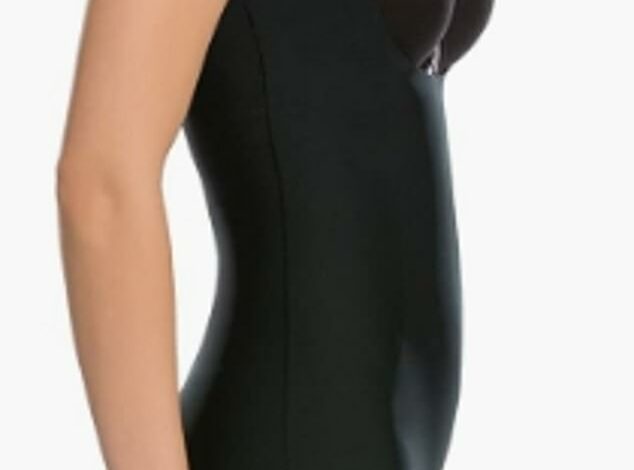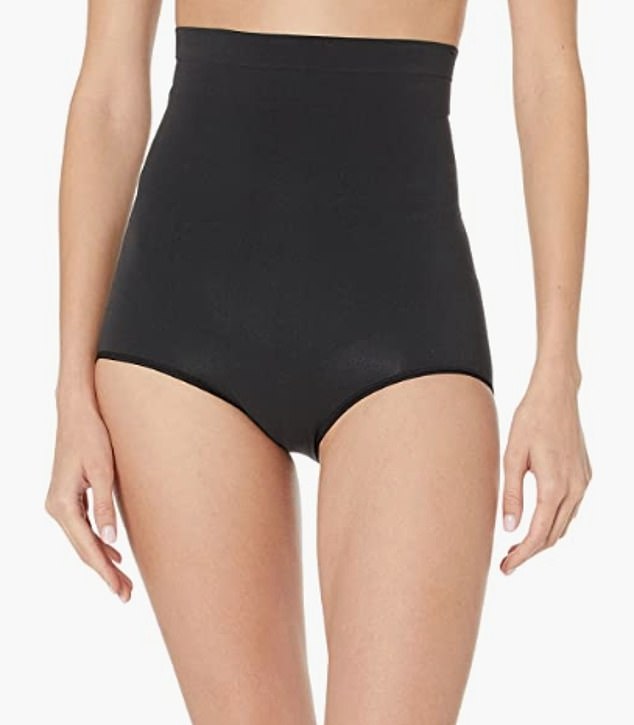Doctors reveal the unusual symptoms that indicate your shapewear is harming your health — including one very embarrassing problem




From shapewear that cinches your stomach to tights that accentuate your buttocks and underwear that squeeze your thighs and arms, shapewear is growing in popularity.
Global revenue is expected to reach almost £3 billion in 2025, up from almost £2 billion in 2019.
While most people (43 percent) want to make their waist appear slimmer, others (17 percent) want to slim their overall figure and 11 percent want to flatten their hips, according to research by fashion company Kaleidoscope.
But could there be a price tag attached when it comes to our health?
Experts warn that these garments can sometimes lead to all kinds of health problems, including urinary tract infections, skin problems and even heartburn.
The idea of using underwear to enhance a woman’s silhouette is of course not new. For centuries, women have achieved a wasp waist by wearing corsets. Some have found that this has had a negative effect on their health.

Innovative fabrics make shapewear more breathable, but modern clothing can still cause health problems
According to a review of studies published in the spring of 2024 in The Classic Journal examining the effects of wearing Victorian corsets, women often suffered from deformed ribs and a condition called “chicken chest,” in which the ribs were compressed so much that they were so weakened that they were on the verge of collapse.
The advent of materials such as Lycra, Spandex and other innovative fabrics to make shapewear more breathable and flexible has meant that most shapewear doesn’t pose such serious risks. But that’s not to say modern clothing doesn’t pose any problems, says Dr Shirin Lakhani, a GP and intimate health expert based in Kent.
“Wearing shapewear occasionally doesn’t have to have negative consequences for your health. But if you wear it all day long, it can cause problems,” she says.
‘It is mainly the overly tight and restrictive garments that are intended to support the abdomen and thighs that cause problems.
‘This is partly because they increase moisture in the genital area, which puts you at greater risk of urinary tract infections, for example. [as the trapped moisture can encourage bacterial growth] or fungal infections, such as thrush.’
The greatest risk, she says, is for women who are in perimenopause — the years leading up to menopause — because during this time, the vaginal lining thins due to a drop in estrogen levels, making it easier for bacterial and yeast infections to develop.
Dr Sarah Jenkins, a GP from London who specialises in women’s health, adds: ‘Women aged 40 and over, who are in perimenopause and whose microbiome [the microbes – bacteria, fungi, viruses – which live in and on our bodies] changes, may be more susceptible to intimate health problems.’

Compression garments that constrict the diaphragm can affect breathing
She says lower levels of beneficial lactobacillus in the vaginal microbiome at this point in life can allow harmful bacteria to take hold.
“You want good airflow and you want the skin to breathe. Shapewear will cause more chafing and sweating in that area – and infection – which leads to ‘bad’ bacteria and a Candida infection [that causes thrush] thrive best in moist areas.’
There’s also a practical issue, says Dr. Lakhani: “Shapewear is uncomfortable to put on and take off. So if you’re wearing tight compression garments, you’re not going to the bathroom as often as you should. And that also puts you at greater risk for UTIs.”
This is because delaying a visit to the toilet can allow bacteria in the bladder to multiply and thrive.
That’s one reason why Dr. Lakhani warns that shapewear should only be used for special occasions, and not for everyday use.
However, wearing them also carries other risks, she says.
For example, she warns that shapewear that is too tight can put pressure on the intestines, stomach and colon, which can worsen digestive issues like bloating, acid reflux and heartburn (when stomach acid leaks into the esophagus, causing a burning sensation).
Dr. Jenkins adds, “If you suffer from acid reflux and you wear compression tights [to shape your waist or hold your stomach in]The extra pressure on your abdomen can cause more acid to come up.’
Additionally, this increase in pressure in the abdomen can increase the risk of incontinence, Dr. Lakhani says.
‘When the pressure in the abdomen increases relative to the pressure of the urethral sphincter [the muscle which controls the flow of urine]”Then we leak.”

‘Anything that restricts blood flow through the body is going to cause problems’ – if a garment is too tight it can cut off circulation
It can even contribute to pelvic organ prolapse (when organs in the pelvis sag due to damage to the surrounding muscles and tissues).
“The effect of tight shapewear is similar to being overweight or pregnant: the increased pressure on your abdomen can put pressure on your organs, pushing them down and out,” says Dr. Lakhani.
Most shapewear is made of nylon, spandex or microfibers. This can lead to rashes, especially in the summer.
Dr Lakhani explains: ‘Synthetic material is stretchy, but you are more likely to get a rash because it is not as breathable as cotton.
Tightness, heat and moisture can cause chafing and irritation.
And hives [itchy lumps caused by an allergic reaction] may be a problem if you are allergic to any of the ingredients in the material.’
One way to avoid these problems is to look for shorts, briefs or bodysuits that have a cotton gusset, Dr. Jenkins advises.
Compression clothing that pinches the diaphragm can also have a negative effect on our breathing.
Dr. Lakhani explains, “Shapewear that is too tight can restrict the movement of the rib cage. The rib cage moves outward and upward, and the diaphragm moves downward when we breathe.
‘In Victorian times, when women wore corsets with no elasticity, they would faint because they couldn’t breathe deeply enough.’
Dr. Jenkins adds: ‘But if your shapewear is causing you to have discomfort like not being able to breathe properly, you have to ask yourself why you are doing this to yourself?
‘Shape underwear should work on your subcutaneous fat and skin layer, and not on your internal organs.
“Also, if you’re wearing it every day and it’s preventing you from moving properly, or it’s affecting your posture, then it can have a domino effect on the muscles.”
Basically, it means they become weaker and less able to attract you naturally.
Tight sports leggings and tops, which are completely different from shapewear that must be tight enough to alter the appearance of the body, can still be problematic, even though they are designed to allow full range of motion.
Dr. Lakhani explains that anything too tight can restrict blood flow.
“If you wear very tight clothing around your abdomen, it can restrict blood flow back to your legs, which can make varicose veins worse,” she says.
“You have blood pumping through your body, so anything that restricts that blood flow is going to cause problems. If a garment is too tight, you’re cutting off circulation to those areas.”
Signs that your shapewear is too tight include marks on the skin, pain when walking, or numbness or tingling. If you experience any of these symptoms, you should take the garment off and go up a size.
There is no evidence that shapewear can permanently change our bodies or make us slimmer, so don’t opt for a tighter fit.
Finally – and perhaps surprisingly – wearing shapewear can have a negative effect on our mental health.
A survey of 2,000 men and women by Opinium last year found that 45 percent of wearers said shapewear negatively impacts their body image, making them feel less confident in the long run. 83 percent of women who bought shapewear said they felt less confident about their body appearance when they didn’t wear it.
Perhaps the solution is to learn to love our bodies more – and let the flabby parts hang free.




